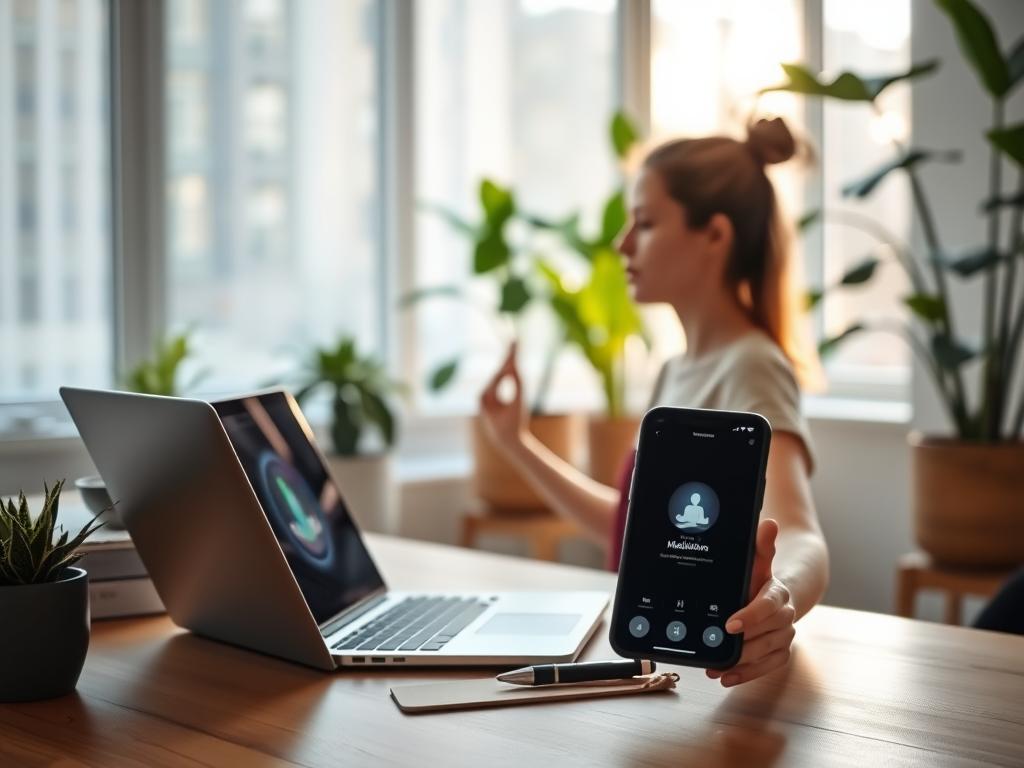In today’s world, we check our phones about 96 times a day. Finding a balance between mindfulness and technology is crucial. The digital revolution changes our lives, making it hard to stay focused and present.
This article looks at how mindfulness and technology meet. It offers tips for a better digital and spiritual life. We’ll cover mindfulness in the digital age and the attention economy. It’s about finding peace in our tech-filled world.
Key Takeaways
- Explore the growing trend of integrating mindfulness practices with technology for enhanced digital wellness
- Understand the challenges of staying present and focused in a constantly connected world
- Discover strategies for cultivating mindful habits and setting healthy boundaries with technology
- Recognize the benefits of mindful technology use, including improved focus, reduced stress, and increased productivity
- Delve into the emerging field of “techno-spirituality” and the role of digital tools in mindfulness practices
The Rise of Mindfulness in the Digital Age
In today’s fast-paced world, mindfulness has become more important. Our digital devices and constant connection are part of our daily lives. Finding balance and staying present is crucial.
Embracing Mindful Technology
Meditation apps like Calm and Headspace have made mindfulness easy to add to our digital routines. They offer guided meditations and sleep stories to help us stay calm and focused.
Also, mindful technology has led to the creation of wearable devices and digital wellness solutions. These tools help us track and manage our technology habits for a healthier life.
Challenges of Staying Present in a Wired World
Even with meditation apps and digital wellness awareness, staying mindful is hard. Notifications, the need to stay connected, and endless scrolling make it tough to stay present.
To overcome these challenges, we need to set boundaries and limit distractions. We must also develop mindful habits. This way, we can thrive in the digital age while keeping our mental health in check.
“In a world that is increasingly digital, the practice of digital wellness and mindfulness has become more important than ever before.”
Understanding the Attention Economy
In today’s world, the fight for our attention is fierce. The attention economy is where digital platforms compete for our limited focus. It has changed how we use technology. Knowing how the attention economy works is key to managing our digital distractions and screen time.
At the core of the attention economy is the endless quest for user engagement. Digital sites use smart algorithms and personalized content to grab our attention. This constant digital push can make it hard to focus and stay in the moment.
The effects of the attention economy are wide-reaching. Too much screen time and digital distractions can harm our productivity, mental health, and well-being. It’s vital to find ways to manage our digital lives and take back control of our attention.
Here are some ways to deal with the attention economy:
- Set limits on screen time and digital media use.
- Practice mindfulness to improve focus and presence.
- Use digital wellness tools and apps to track and limit distractions.
- Make time for face-to-face interactions and offline activities to keep a healthy balance.
“The ability to focus attention on important things is a foundational capacity – much like running, walking, or riding a bicycle.” – Daniel Goleman, author of “Focus: The Hidden Driver of Excellence”
By grasping the attention economy and using smart screen time management, we can take back control of our digital lives. This leads to a healthier, more balanced relationship with technology.
Mindfulness and Tech: A Delicate Balance
In today’s world, technology is a big part of our lives. Finding a balance between mindfulness and tech is hard. We need to be aware of digital distractions that can make it hard to stay present.
Recognizing Digital Distractions
Notifications, alerts, and endless social media can pull us away. It’s important to know what distracts us. By understanding these distractions, we can find ways to stay focused.
Cultivating Mindful Habits
- Set boundaries: Create times and places where you don’t use tech, making them digital-free zones.
- Practice digital minimalism: Clean up your devices, stop getting too many notifications, and only use apps that matter to you.
- Engage in mindful technology use: Use tech with purpose, focusing on what you’re doing instead of just scrolling.
- Incorporate digital wellness routines: Add mindfulness, like meditation, to your tech time to make it more mindful.
By knowing what distracts us and making mindful choices, we can find a balance. This balance lets us enjoy tech’s benefits while staying present and focused.
“The greatest weapon against stress is our ability to choose one thought over another.” – William James
The Benefits of Mindful Technology Use
In today’s world, finding a balance between tech and mindfulness is key for our well-being. Using technology mindfully can bring many benefits. These include better focus, more productivity, and less stress and anxiety.
Improved Focus and Productivity
Being mindful of our tech use helps us avoid distractions. This lets us stay focused on what we need to do. By setting limits and developing mindful habits, we can get more done faster.
This not only makes us more efficient but also boosts our job satisfaction. We feel more accomplished and happy with our work.
Reduced Stress and Anxiety
The constant stream of notifications and emails can make us feel overwhelmed. But, using technology mindfully can help us feel less stressed and anxious. By taking breaks and practicing relaxation, we can calm our minds.

“The key is not to prioritize what’s on your schedule, but to schedule your priorities.” – Stephen Covey
Embracing mindful tech use can greatly benefit our lives. It helps us stay focused, productive, and calm. A mindful approach to technology is essential for thriving in our digital world.
Meditation Apps and Digital Wellness Tools
In today’s digital world, meditation apps and wellness tools have changed how we think about mindfulness and mental health. These new technologies make it easy to add mindful practices to our daily lives. They offer many features and benefits to help us stay well in the digital age.
Meditation apps like Calm, Headspace, and Insight Timer are very popular now. They offer guided meditations, sleep stories, and mindfulness exercises. You can use them anytime, anywhere, fitting meditation into your busy schedule. These apps also give personalized advice, track your progress, and have community features to make your experience better.
There are also digital wellness tools like apps for managing screen time, browser extensions, and smart device features. These tools help us stay healthy in our tech use. They have features like blocking distractions, setting time limits, and reminding us to take breaks. They help us be more mindful of our tech habits and what’s important to us.
“The integration of meditation apps and digital wellness tools has been a game-changer for those seeking to find a balance between the demands of technology and the need for mindfulness and inner peace.”
As we move through the changing digital world, these meditation apps and digital wellness tools are key. They help us have a better, more balanced relationship with technology.
Leveraging Meditation Apps for a Mindful Routine
Meditation apps have many features to help with mindfulness and well-being. Some of the main benefits are:
- Guided meditations for beginners and experienced practitioners
- Customizable meditation sessions based on time, focus, or desired outcome
- Sleep-enhancing audio tracks and bedtime stories
- Progress tracking and personalized recommendations
- Access to a supportive community of fellow practitioners
By using these meditation apps daily, we can build a consistent mindfulness practice. This can lead to less stress, better focus, and overall better well-being.
Techno-Spirituality: Merging Technology and Mindfulness
In today’s digital world, technology and mindfulness are coming together in exciting ways. This new field, techno-spirituality, combines modern tech with ancient wisdom. It uses virtual reality and wearable tech to help us live more mindfully.
Virtual Reality and Mindfulness Experiences
Virtual reality (VR) is changing how we practice mindfulness. It takes us to peaceful places, like nature, for deep meditation. VR helps us focus, relax, and find inner peace.
Wearable Tech for Mindful Living
Wearable tech, like fitness trackers, is also key in techno-spirituality. These devices track our body’s signals, showing us how calm or focused we are. They help us understand our mental and physical health better, leading to a more mindful life.
Techno-spirituality is a promising area that blends tech and mindfulness. It opens up new ways to know ourselves better, find balance, and connect with now.

Mindfulness and Tech in the Workplace
The world of work is changing fast, and so is how we use technology. Employees today face many distractions like notifications and emails. But, by using technology mindfully, companies can help their teams focus better and feel better overall.
Using technology wisely can make employees more productive. By setting limits on emails and social media, workers can focus on their main tasks. This leads to better work, smarter decisions, and a more team-friendly work place.
Mindfulness practices, like meditation, also help in the busy tech world. Taking short breaks to be present can refresh both mind and body. This makes employees happier, less stressed, and more digitally well.
To bring mindfulness and tech together at work, companies can try several things:
- Offer mindfulness workshops and training sessions for employees
- Provide access to mindfulness and meditation apps or platforms
- Encourage the use of tools like the Pomodoro method to boost productivity
- Support a culture that values focus, wellness, and work-life balance
By finding the right balance between tech and mindfulness, companies can help their teams succeed. This approach to well-being at work can make employees happier, more collaborative, and more productive.
Screen Time Management Strategies
In today’s world, managing screen time is key to a healthy balance. Setting limits helps people control their tech use. It also helps them have a better relationship with digital devices.
Setting Boundaries and Limits
Setting times for tech use is a good start. For example, making some areas tech-free or having a “digital sunset” in the evening helps. Also, using apps or phone features to limit screen time can help cut down on too much use.
Digital Detox and Unplugging
Taking breaks from digital devices can improve focus and mental health. It also helps us connect with the moment. Whether it’s a weekend or a week, taking a break from tech can recharge us.